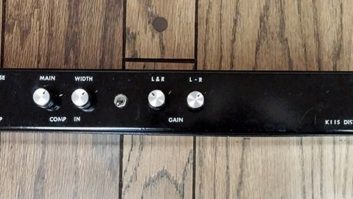The author is senior product design engineer for audio processing for Wheatstone.

Thanks to Glynn Walden for his questions in last month’s Radio World Reader’s Forum (Jan. 3 issue) regarding KSDS’ multipath findings using the multipath limiter in the AirAura X3 audio processor.
As background, Glynn responded to KSDS engineer Scottie Rice’s claim in a Radio World User Report that he was able to reduce the effects of multipath by using the processor’s Multipath Limiter, a Wheatstone algorithm that manages L–R modulation under tightly defined, program-dependent conditions.
Glynn’s first question asked how modifying the L-minus-R could have such a profound effect on reception given the multipath reduction algorithms in radios today.
It’s important to remember that, technically, multipath is a physical phenomenon where reflecting objects, such as buildings and mountains, cause a receiver to “see” a station’s signal from more than one direction.
The only real cure for multipath? Remove the reflecting objects. (Got a bulldozer?)
One of the reasons multipath is so annoying on stereo receivers is that many aggressively blend to mono during multipath, creating large fluctuations in volume as the stereo sound field collapses. The wider the stereo image, the more obvious the blending, and that’s why “stereo enhancement” earned the reputation of creating multipath.
But stereo enhancement doesn’t create multipath; it just makes it seem worse because blending then has to squash down a much bigger stereo sound field.
Transmitting in mono would remove the stereo sound field collapse due to blending, leaving just the noise and distortion effects. Stations that transmit in mono get two benefits, then: no stereo pilot means that most receivers aren’t looking at the L–R subcarrier for audio; and there’s no blend to mono, so volume fluctuations due to multipath are absent.
MULTIPATH LIMITER
But what if you could transmit in stereo and still get some of the benefits of transmitting in mono? That’s where Wheatstone’s Multipath Limiter comes into play.
What our Multipath Limiter does is reduce the magnitude of volume fluctuations due to multipath-induced blending by managing a program content’s L+R/L–R ratio under very specifically controlled conditions.
By intelligently allowing only enough stereo information to fool the ear into believing it’s a full stereo signal, the audibility of blending is reduced. The psychoacoustic result, then, is that multipath has been reduced and perceived coverage improved, cautiously noting that perceived stereo coverage is only loosely related to the station’s RF field strength.
I should mention that interesting things have been learned from field research during the development of our FM-HD tuner-based diversity delay correction. One is that newer DSP-based receivers seem more prone to multipath effects, even though most have mechanisms to supposedly minimize it. Others are that those receivers lack the modulation headroom of older technology, and definitely don’t behave well with non-standard stereo multiplex signals (like single sideband) or a dirty MPX spectrum (think composite clipping). In fact, the latter is precisely why our FM processors have both a composite clipper and a lookahead MPX limiter; the user can choose which algorithm works best for his scenario.
The bottom line is this: Clean up the MPX spectrum and intelligently manage the L+R/L–R ratio and prepare to be surprised, as was KSDS and others, how perceived stereo coverage (not signal strength!) goes up.
Speaking of signal strength, Gynn’s observation about the predicted signal within KSDS’ coverage area is right on the money, but coverage predictions are only part of the story.
Those of us who tinkered with synchronous AM in the old days quickly learned that how a receiver responds to our signal and then demodulates it is wholly dependent on what we actually transmit.
So when customers say that something reduced multipath on their station and nothing’s been bulldozed down, what they’re really saying is that the perception of multipath has been reduced. Our processors accomplish that by intelligently modifying what stereo receivers do when they detect multipath and how they sound while doing it. Nothing more.
Glynn said that even under ideal conditions it’s impossible to compare tests made at different times and that he’d like to see the tests repeated on multiple receivers. It just so happens that those tests have not only already occurred, but are being repeated over and over again every day. KSDS’s experience is right in line with myriad comparisons made over more than a decade of trials in the U.S. and Europe.
Do our multipath and lookahead MPX limiters reduce the effects of multipath for every station? Nope. Nothing does, and there are a lot of variables. But they’ve been repeatedly evaluated and compared in countless ways, and more often than not, they do.
Those interested in reading about my original research can find my NAB 2013 paper here: goo.gl/o3C8FC.
The Multipath Limiter algorithm itself is typical “problem-solving broadcast engineer,” and its roots go way back to the ’90s, when I was CE of WMJI in Cleveland.
More than 20 years later and in markets where our FM processors and the Multipath Limiter are in use, we’re seeing the same kind of correlations we saw at WMJI.
Here’s a video about how and why I developed the algorithm and then accidentally discovered its completely unexpected benefit on perceived multipath: https://youtu.be/1sdzoZooS5o.












